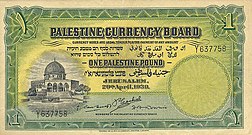Our website is made possible by displaying online advertisements to our visitors.
Please consider supporting us by disabling your ad blocker.
Palestine pound
 A 1939 one Palestine pound note | |
| Unit | |
| Symbol | £P or LP |
| Denominations | |
| Subunit | |
| 1⁄1000 | Mil |
| 1⁄1000 | Prutah (from 1950 in Israel) |
| Banknotes | 500 mils, £P1, £P5, £P10, £P50, £P100 |
| Coins | 1, 2, 5, 10, 20, 25, 50, 100 mils, 1, 5, 10, 25, 50, 100, 250, 500 prutot |
| Demographics | |
| Replaced | Egyptian pound (Mandatory Palestine) |
| Replaced by | Jordanian dinar (Jordan and West Bank) Egyptian pound (All-Palestine Protectorate)(Gaza) Israeli pound (Israel) |
| User(s) | |
| Issuance | |
| Central bank | Palestine Currency Board |
| Printer | Thomas De La Rue |
| This infobox shows the latest status before this currency was rendered obsolete. | |

The Palestine pound (Arabic: جُنَيْه فِلَسْطَينِيّ, junayh filastini; פונט פלסטיני |funt palestina'i or Hebrew: לירה, romanized: lira Palestinay'it; Sign: £P[1][2][improper synthesis?]) was the currency of the British Mandate of Palestine from 1 November 1927 to 14 May 1948, and of the State of Israel between 15 May 1948 and 23 June 1952, when it was replaced with the Israeli pound.
The Palestine pound was also the currency of Transjordan until 1949 when it was replaced by the Jordanian dinar, and remained in usage in the West Bank of Jordan until 1950. In the Gaza Strip, the Palestine pound continued to circulate until April 1951, when it was replaced back with the Egyptian pound.
- ^ As depicted on a revenue stamp issued under the Mandate.
- ^ As depicted on a Barclays cheque
Previous Page Next Page


